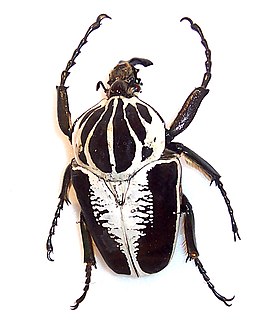
The Goliath beetles are any of the five species in the genus Goliathus. Goliath beetles are among the largest insects on Earth, if measured in terms of size, bulk and weight. They are members of subfamily Cetoniinae, within the family Scarabaeidae. Goliath beetles can be found in many of Africa's tropical forests, where they feed primarily on tree sap and fruit. Little appears to be known of the larval cycle in the wild, but in captivity, Goliathus beetles have been successfully reared from egg to adult using protein-rich foods such as commercial cat and dog food. Goliath beetles measure from 60–110 millimetres (2.4–4.3 in) for males and 50–80 millimetres (2.0–3.1 in) for females, as adults, and can reach weights of up to 80–100 grams (2.8–3.5 oz) in the larval stage, though the adults are only about half this weight. The females range from a dark brown to silky white, but the males are normally brown/white/black or black/white.

Goliathus goliatus is a species of beetles of the family Scarabaeidae.

Goliathus orientalis is a species of beetles belonging to the family Scarabaeidae.
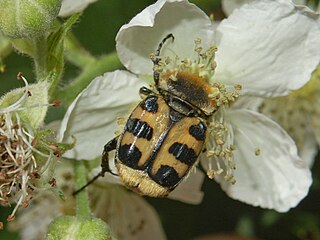
Trichius gallicus is a beetle species belonging to the family Scarabaeidae, subfamily Cetoniinae. It frequently appears in the literature under the name "Trichius rosaceus", but this name is permanently unavailable under ICZN Article 11.4, as are all of Voet's names.

Tropinota squalida is a species of beetle belonging to the family Scarabaeidae, subfamily Cetoniinae.

Stephanorrhina princeps, common name spotted flower beetle, is a beetle from the family Scarabaeidae, subfamily Cetoniinae and tribe Goliathini.

Stephanorrhina is a genus of the family Scarabaeidae, subfamily Cetoniinae and tribe Goliathini.

Stephanorrhina julia is a species of beetles of the family Scarabaeidae, subfamily Cetoniinae and tribe Goliathini.

Theodosia viridiaurata are beetles from the family Scarabaeidae, subfamily Cetoniinae, tribe Phaedimini.

Stephanorrhina guttata, common name spotted flower beetle, is a species of beetles of the family Scarabaeidae, subfamily Cetoniinae and tribe Goliathini.
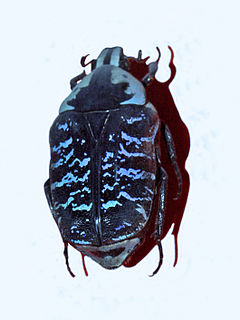
Euchroea coelestis is a species of beetles of the family Scarabaeidae and subfamily Cetoniinae.
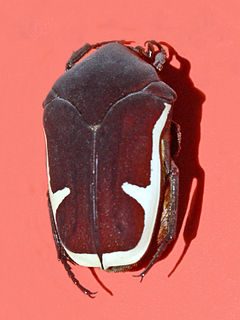
Gymnetis holosericea is a species of beetles of the family Scarabaeidae and subfamily Cetoniinae.
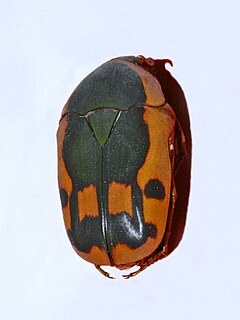
Pachnoda impressa, the green and yellow fruit chafer, is a species of beetles of the family Scarabaeidae and subfamily Cetoniinae.

Phaedimus cumingi is a beetle species belonging to the family Scarabaeidae, subfamily Cetoniinae.

Mecynorhina passerinii, the Orange-Spotted Fruit Chafer, is a species of beetles belonging to the family Scarabaeidae, subfamily Cetoniinae.

Mecynorhina harrisi is a species of beetles belonging to the family Scarabaeidae, subfamily Cetoniinae.
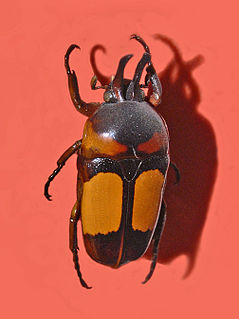
Dicheros bicornis is a species of beetles belonging to the family Scarabaeidae, subfamily Cetoniinae.

Chondrorrhina abbreviata is a species of fruit and flower chafers belonging to the family Scarabaeidae, subfamily Cetoniinae.
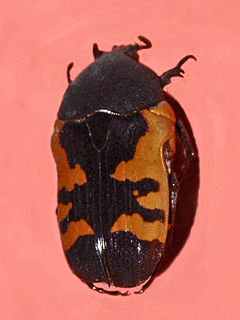
Polybaphes sanguinolenta is a species of fruit and flower chafers belonging to the family Scarabaeidae, subfamily Cetoniinae.
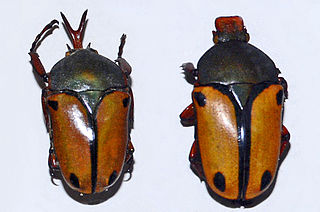
Eudicella smithiiis a species of African scarab beetle in the subfamily Cetoniinae, the flower beetles.



















